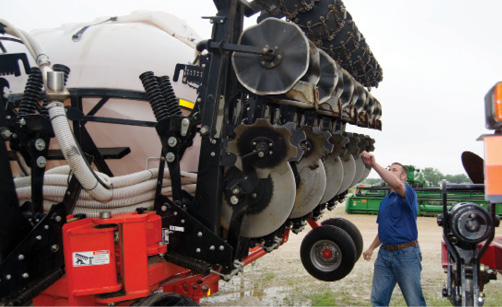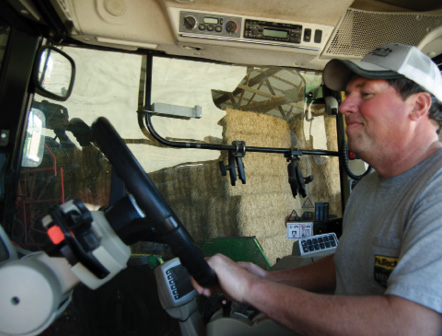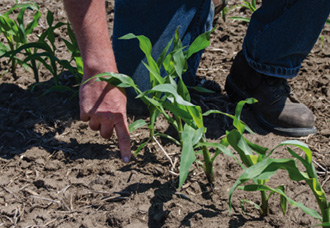GIVE AND TAKE. Janesville, Wis., strip-tillers Dan, David and Doug Rebout build their strips exclusively in the spring to avoid having anhydrous leach from the soil over the winter. However, this method exposes them to both the possibility of the increased compaction that comes with a spring pass and a tighter planting window.
Some farmers see switching to strip-till as a leap of faith. Luckily, for the Rebout family in Janesville, Wis., it was a gamble that paid off both immediately and in the long run.
In partnership, brothers Dan, Doug, David and their mother, Mary Joan, adopted strip-till 15 years ago on the family farm at the suggestion of their father, the late Roger Rebout.
“Our dad was on the corporate board of Associated Milk Producers and on the National Dairy Board, so he had the opportunity to talk to farmers from all around the country,” says Doug. “He met some farmers who were strip-tilling and really liked the idea, so he brought it home.”
The Rebout family farm includes a 700-head cattle dairy operation and 3,900 acres of farmland. Today, they strip-till all 2,500 acres of corn and no-till their soybeans, wheat and alfalfa.
Precision Perks of Early Adoption
When initially adopting strip-till, the Rebouts started on a limited scale. Farmers new to strip-till can face a hefty upfront investment, but by getting started 15 years ago, the Rebouts have been able to grow into technology as it emerged.
“When we first got into strip-tilling, we just went over soybean ground,” Doug says. “We wanted to do more, but before auto-steer, we couldn’t see the rows in corn-on-corn ground very well and we’d keep plugging up. Getting Deere’s GreenStar RTK about 8 years ago helped with that. Since then we’ve adopted strip-tilling more widely.”

SYCHRONIZED FERTILIZER APPLICATION. The Rebouts apply both anhydrous and dry fertilizer through their 16-row Kuhn Krause Gladiator mounted with a Montag dry fertilizer cart. By matching the application rates of each product, they are able to refill both types at the same time, rather than having to stop in between. This saves time in the already stressed spring season.
Having seen decreased stands from missing the strip during planting, they installed their own base station on the farm at the first opportunity. They’re in the advantageous position of having the majority of their acreage adjoining rather than spread out and broken up.
This means that owning their own base station is more cost effective than leasing one. Utilizing RTK for strip-till — which the Rebouts now consider essential — has cut out more inefficiencies than just missing the strip with their rig and planter.
“For harvesting, we can get within 6 inches at each pass, and we don’t have any wavy or curvy lines with soybeans,” says Dan. “Also, there’s no more overlap when we’re spraying. There are considerable savings in both.”
Narrow Planting Window
The Rebouts are strict spring strip-tillers and do the majority of their fertilizer application at that time — banding anhydrous ammonia and dry fertilizer through a recently purchased 16-row Kuhn Krause Gladiator with a mounted Montag dry fertilizer cart.
They build their strips 8 inches deep and 8 inches wide, and band 200 pounds per acre of nitrogen (N) 6 inches deep. They also apply 125 pounds per acre of potash, 50 pounds of phosphorus (P) and 25 pounds of ammonium sulfate (AMS) 4 inches deep. They also add Wolf Trax micronutrients to their dry fertilizer mix.
At planting, the Rebouts apply an additional 5 gallons per acre of pop-up fertilizer in-furrow with their 24-row John Deere 7200 planter. After planting, they spray herbicide and sometimes fungicide with their Miller Nitro self-propelled sprayer, with a 90-foot boom.
“We saw a 15-bushel per acre bump in yield right away across multiple hybrids…” —Doug Rebout
By building strips exclusively in the spring, the Rebouts feel they avoid having anhydrous ammonia leech from the soil over the winter. However, strip-tilling in the spring puts them at risk for increased compaction and a frenetic planting widow. The Rebouts have developed a program to mitigate these obstacles.
“A lot of people ask me how we can even think about spring strip-tilling when we don’t know what sort of planting window we’ll get,” says Dan. “Sure, we’ll get a little compaction if the soil is still too damp, but it’s usually just in the tractor tracks. We just have to start strip-tilling as soon as possible in the spring.”
To head off the time crunch, the Rebouts know they have to hit the field hard as soon the opportunity arises. They use long hours and seasonal indicators to ensure their strips are built quickly and properly.
“Once I start strip-tilling, my average days are 6 a.m. till 10 p.m.,” Dan says. “I start with a test pass and I look for three factors to tell me it’s time to start. First, that the soil is dry enough to the point where I won’t be leaving a lot of compaction. Second, that the anhydrous is sealing. Third, that the berm I’m building isn’t lumpy.”
To further hedge against an unpredictable spring, the Rebouts have a 16-row Progressive strip-till rig on standby that can be run simultaneously with the Gladiator to cover ground faster.

FEWER TRIPS, LIGHTER LOAD. Dan Rebout says since switching to strip-till, the benefit of less wear and tear on their tractors is two-fold. The tractor has to do fewer trips across the field and the strip-till rig pulls less than a chisel plow would. These factors have also fed into a roughly 30% fuel savings.
Building strips too early is one potential stumbling block, but the Rebouts are also careful to consider potential seed burn if they plant too early. They try to run the planter 2 weeks behind of the strip-till rig to avoid this, but sometimes conditions prevent the ideal scenario.
“With the anhydrous, I want to give the strip at least 10 days to mellow,” Dan says. “It’s not the norm, but there have been a few times we’ve come up behind the strip-till machine 3-4 days afterward and saw a bit of seed burn. Sometimes you just have to get the work done when you have the chance.”
The Rebouts try to further speed up strip-tilling by matching their fertilizer application rates for efficient refilling. By synchronizing the anhydrous and dry fertilizer rates, they’re able to refill on a more convenient rotation.
“I’ve got a 5-ton fertilizer box and can usually do 20 acres with my anhydrous tank,” says Dan. “I’ve matched the rates of dry fertilizer up with the anhydrous perfectly so every other time I hook up for an anhydrous fill-up, I can fill back up with dry fertilizer too.”
Long-Term Benefits
Some of the benefits of adopting strip-till leapt out immediately for the Rebouts, encouraging them to expand the process. They saw a 15-bushel-per-acre bump in corn yield right away across multiple hybrids.
Initially lured to the practice by fuel and labor savings, the yield bump was a pleasant surprise. The savings, along with reduced wear and tear on equipment and moisture retention in soils, has further galvanized their dedication.
“We shaved off two extra field passes, so our tractor is out in the field less, saving on compaction and wear and tear,” Dan says. “On top of that, even on the one pass we do, the strip-till rig doesn’t work the tractor nearly as hard as a chisel plow. The gas savings were immediately noticeable, somewhere around 30%, which for our acreage is huge.”
Some of the cumulative benefits have taken a bit longer to appreciate. Dan noticed the increased soil moisture retention in strip-till is especially useful in unseasonably dry conditions.

DROOP NO MORE. In an area with a lot of conventionally tilled corn, the Rebout family farm stands out for it’s resilience in dry conditions. Doug Rebout says in drought situations, their strip-tilled corn holds out at least 2 weeks longer than conventionally tilled before showing signs of wilting and yellowing.
“The corn stalk cover in the rows keeps the rainwater in, not letting it evaporate,” Dan says. “Coming through with a chisel plow stirs up the topsoil and dries it out too much. Last year, we had strip-tilled ground next to some ground that we had to conventionally till. We ended up having about 6 weeks of dry weather that year, and because of that there was 40-bushel-per-acre drag on the conventionally tilled ground.”
The resilience the Rebouts have developed over the years to strip-till challenges can be seen from the road just passing through.
“A lot of corn around here is still conventionally tilled,” says Doug. “In a drought situation, we’ll see a ton of yellowing and wilting corn in our area, but our strip-tilled corn-on-corn will last at least a week longer before showing any signs of wilting.”
The Rebouts have also noticed that after heavy rains there aren’t large amounts of fresh soil in their waterways like there was when they were conventionally tilling. Without the washing and erosion, the Rebouts were able to do away with their contours.
“The less we can disturb that soil, the less erosion we’ll have,” Dan says. “Going right over hills that used to have to be contoured is a big benefit because we don’t have to try to fill in all the odd spots anymore.”
While variable-rate broadcasting anhydrous in the fall to build up their low spots, David noticed another benefit that took time to materialize.
“I’ve matched rates of dry fertilizer up with anhydrous so every other time I’m back for a fill-up, I can fill dry fertilizer, too…” —Dan Rebout
“We variable-rate off a 5-acre grid sample on a 4-year soil-testing cycle,” he says. “We’ve noticed that with strip-tilling, we’re getting more fertilizer into the soil, so as we variable-rate we’ve had to apply less and less.
“Both pounds per acre and actual acres that we broadcast have gone down because the fertility is getting to the point where we want it.”
Always Experimenting
Invariably, the Rebouts’ spirit of experimentation has led them to keep on the look out for possible improvements to their existing practice. In another attempt to buy time in early spring, Dan recently started sizing the heavier corn-on-corn residue in the fall with a Turbo-Max vertical tillage unit made by Great Plains Mfg.
“We just started this 2 years ago,” says Dan. “Our new Gladiator cuts through the heavy residue better than the Progressive unit ever did, but vertical tillage helps prevent plug-ups during planting. I just can’t have that kind of downtime in the spring when I need to keep moving.”
Other experimentation includes recently spraying on Headline fungicide with their herbicide application. They remain unsure of the effectiveness of a sprayed-on application, but they have seen encouraging results from their in-furrow fungicide application.
“Representatives from BASF came out and we put some Headline in-furrow at planting,” says David. “They set up cameras on certain spots so we could monitor its performance throughout the season.
“In areas with a lot of corn stalk material and cover on the top, it seemed like the corn came through it quicker and the yield maps showed a bump all the way up to 12 bushels better in some spots. On average it was about 7-bushel advantage.”
The Rebouts won’t lean to heavily on a single year of results, but they’re repeating their tests to see if there is consistency.
“We’re always willing to experiment,” David says. “If we can gain a few bushels without spending too much money, we’re always willing to go after it.”
Planting and Residue Sizing Experiments with Soybeans
Responding to industry talk that no-tilling soybeans in 15-inch rows, rather than drilling them in at 7½-inch spacings like they’ve been doing, the Rebout brothers, Dan, David and Doug recently ran an in-field trial.
“Everyone kept saying that drilling wasn’t the way to go, and we should be in rows instead,” Dan says. “About 2 years ago we took 80 acres and just decided to test it out. We did 30-inch rows and 15-inch rows separately with our corn planter and drilled on our usual 7½-inch spacings next to that.”
They ran 240 feet worth of each different spacing type in test strips. When it came time to review the yield data, the results were bittersweet.
“There was less than a half bushel-per-acre difference between all the methods,” David says. “What it did show us was that we could cut our soybean populations down in our 15- and 30-inch rows vs. drilling. We were drilling with 180,000 seeds per acre, but only running 140,000 through the planter. We saved on seed, but we’d have to buy another planter to do that, which wouldn’t pay for itself over the next 10 year with the seed savings.”
Another soybean test they’ve been running is using vertical tillage to better size corn-on-corn residue. Last year, they ran their Great Plains Turbo-Max vertical tillage tool in the fall ahead of planting soybeans in the spring.
Yield data already has Doug questioning whether or not the extra tillage pass on the field was worth it.
“After trying it, I’m thinking that saving the trip across the field might be more valuable,” says Doug. “All we’re doing is cutting up the stalks and leaving everything to lay on top of the soil, and that can cause trouble with emergence. Where we’re still no-tilling, the stalks aren’t cut down so we have that much less residue on the ground.”
The results on the bottom line have the Rebouts considering a switch back to full no-till without the vertical-tillage pass.
“We’ve always averaged about 60-bushels per acre of soybeans, and yield-wise on our farm there hasn’t been a whole lot of difference between conventional tillage and no-till,” he says.







